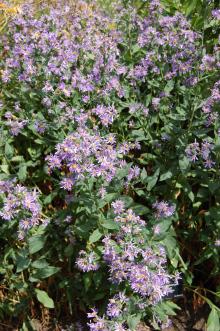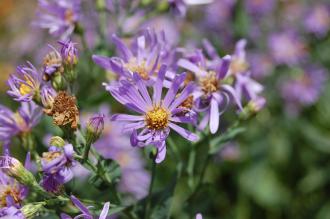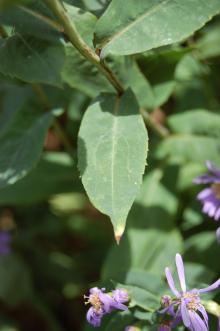
Symphyotrichum laeve (27/07/2013, Kew Gardens, London)
Position: Full sun to light shade
Flowering period: Late summer
Soil: Moist, well drained
Eventual Height: 1.2m
Eventual Spread: 60cm
Hardiness: 3a, 3b, 4a, 4b, 5a, 5b, 6a, 6b, 7a, 7b, 8a, 8b, 9a
Family: Asteraceae
Symphyotrichum laeve is a deciduous herbaceous perennial with an upright habit. Its dark green leaves are elliptic with serrulate margins, up to 7cm long and 3cm broad. Its stems are erect. Its purple/ pale purple flowers have yellow centres and are up to 3cm cross. Its fruit is a one seeded achene which readily germinate. Its roots are short rhizomes.
Symphyotrichum laeve, commonly known as the Smooth Aster, Smooth Blue American Aster or Smooth Leaved Aster, is native to much of USA. In its native habitat it typically grows in prairies and open woodland.

Symphyotrichum laeve Flower (27/07/2013, Kew Gardens, London)
The etymological root of the binomial name Symphyotrichum is derived from the Greek sympho meaning ‘to grow together’ and trichos meaning ‘a single hair’. Laeve is derived from the Latin levis meaning ‘smooth’.
The landscape architect may find Symphyotrichum laeve useful as part of a prairie type planting scheme. Once established this perennial is drought tolerant.

Symphyotrichum laeve Leaf (27/07/2013, Kew Gardens, London)
Ecologically, Symphyotrichum laeve flowers are attractive to nectar loving insects.
Symphyotrichum laeve prefers moist, fertile, well-drained soils. It tolerates most pH of soil.
Symphyotrichum laeve requires little maintenance. Dead flower heads may be removed to prevent self seeding. Large clumps may be divided in spring.

